
The International Congresses of Mathematicians (ICMs) take place every four years at different locations around the globe. They are the largest regular gatherings of mathematicians from all nations (the 2014 congress in Seoul attracted over 5,000 delegates from 122 countries), and provide a forum for the award of one of the premier prizes in mathematics: the Fields medal. However, as much as the assembled mathematicians may like to pretend that these gatherings transcend politics, they have always been coloured by world events.
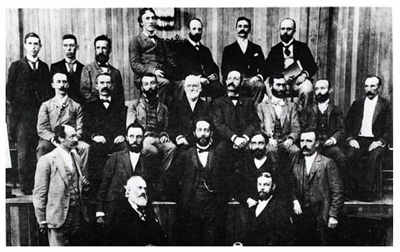
A picture from the zeroeth ICM in Chicago, 1893.
The ICMs have their origin at the end of the nineteenth century, at a time when improved communications and transport connections, as well as a period of relative peace over much of Europe, led to a great expansion in international scientific activities (where "international" usually meant just Europe and North America). A very small conference, often termed the "zeroeth ICM", took place in Chicago in 1893, but the first truly international gathering of mathematicians was that held in Zurich in 1897, attended by around 240 delegates from 16 countries – rather modest when compared to more recent ICMs, but evidently successful enough that further congresses were planned.
The 1897 congress was followed in 1900 by a second, held this time in Paris, alongside the many other conferences and exhibitions that were being staged there to mark the new century. A noteworthy feature of the Paris ICM was a lecture given by the respected German mathematician David Hilbert, in which he outlined a series of problems that he thought ought to be tackled by mathematicians in the coming decades. Hilbert's problems went on to shape a great deal of twentieth-century mathematical research; just three remain entirely unresolved (see here for an example of one of the problems).
Rising tension
Following the Paris congress, a four-yearly pattern was established for the ICMs, and so the next one was held in Heidelberg in 1904. It is here that we begin to see clearly some of the political tensions that would shape the later conduct of the congresses: whereas a large number of German mathematicians had attended the Paris ICM, the Heidelberg congress saw comparatively few French delegates – defeat in the Franco-Prussian war of 1870-1 was still a rather raw memory for some. Overall, however, the 1904 congress had the largest attendance yet (almost 400). At the end of the nineteenth century, Germany had been a popular place for people to study mathematics, and it seems that many mathematicians from abroad had relished the excuse to go back.
With three successful congresses having been held, the ICMs had become well established, and further meetings were held in Rome in 1908, and then in Cambridge in 1912. At the latter, it was agreed that the next congress would take place in Stockholm, however it proved impossible to hold an ICM in the war-torn Europe of 1916.
Between the wars
After the end of the First World War, the mathematicians of Western Europe realised that something ought to be done to help to rebuild their discipline and its international networks. To this end, an International Mathematical Union (IMU) was formed, one of whose immediate tasks was to re-establish the ICMs by staging one in 1920.
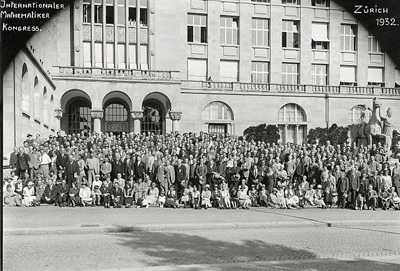
The 1932 ICM in Zurich.
However, Stockholm was not to be the venue. The leading members of the IMU, many of whom hailed from the Western European countries that had been particularly devastated by the war – France and Belgium, for example – chose instead to make a bold statement by selecting Strasbourg: a French city that had been incorporated into Germany following the Franco-Prussian War, and that had just been returned to France by the Treaty of Versailles. In fact, more than this, and despite strong protests from such figures as the English mathematician G. H. Hardy, all mathematicians from Germany and her wartime allies were barred from attending the congress – it was a founding principle of the IMU that Germany should never again be allowed to participate in international mathematical activities.
The exclusion of German mathematicians extended also to the 1924 congress in Toronto – indeed, the congress had originally been planned for New York, but the American Mathematical Society, which would have played host, failed in its efforts to persuade the IMU to lift the ban and so withdrew its support. The congress was only able to go ahead when J. C. Fields, who would later institute the medal that bears his name, offered to host the event at the University of Toronto. By 1928, however, the pressure on the IMU had become too great, and it was forced to admit German mathematicians to the congress that took place in Bologna that year. From this time on, the ICMs began to take on an existence independent of the IMU, as the influence of the latter waned.
Despite (or, in some cases, because of) the re-opening of relations with German mathematicians, tensions remained in the international mathematical community. Naturally, there were people who believed that the Germans should not have been re-admitted to the ICMs. Moreover, some German mathematicians felt resentment at their earlier exclusion and so boycotted the 1928 congress. In a bid to bring people back together and re-establish ties, the ICM returned in 1932 to Zurich – a deliberately neutral choice. Similar reasoning resulted in Oslo being chosen as the venue for the 1936 ICM, a congress that is significant for the award of the first Fields Medals: to the Finn Lars Ahlfors and to the American Jesse Douglas.
Darkening times
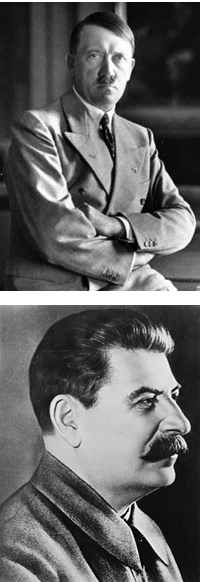
Political agendas dominated the 1936 ICM in Oslo. (Picture of Hitler: German Federal Archives, CC BY-SA 3.0 DE.)
From the start, the Oslo ICM was a political melting pot of different agendas. The Norwegian hosts, for example, seized upon the opportunity to promote Scandinavian mathematics on an international stage. The wider European political situation also had its effects, with delegations of mathematicians expected from Hitler's Germany, Mussolini's Italy, and Stalin's USSR – though in the end only the first of these groups appeared. The Italians, for example, boycotted the congress in protest at Norway's condemnation of the Italian invasion of Abyssinia.
The goal of the Nazi-led German contingent was clear: to showcase the best of "Aryan mathematics". The German delegation was instructed to be on its best behaviour, to refrain from making racial comments, and to proudly use the German language at all opportunities. The tension that had existed between French and German mathematicians at earlier congresses was present here too, and was expressed through a rivalry over who could "claim" Norway's mathematical heroes Niels Henrik Abel and Marius Sophus Lie, each of whom had spent time both in France and in (what became) Germany.
The Soviet delegation, on the other hand, was conspicuous by its absence. Like the Germans, Russian mathematicians had had a difficult relationship with the ICMs. Prior to the First World War, they had regularly attended in significant numbers, but had been rather less visible during the 1920s, following the October revolution (1917) and subsequent Russian civil war (1917-1922). As the decade progressed, they began to reappear, but their attendance was sometimes made difficult by the fact that the USSR lacked official recognition by some world governments.
By the end of the 1920s, Stalin was firmly in power in the USSR, and one of the things that he sought to do as he cemented his position was to exercise greater control over the Soviet scientific community. The ability of Soviet academics to travel to foreign conferences was gradually curtailed: whilst, for example, Soviet mathematicians managed an attendance of almost forty at the 1928 ICM, this dropped dramatically to just three in 1932.
At the Oslo congress, around eleven Soviets were expected to attend but when the congress convened in July 1936, it was announced that none of the Soviet delegates had in fact appeared. In an atmosphere in which scientists' foreign connections were increasingly regarded with suspicion by the Soviet authorities, each of the delegates expected from the USSR had been denied permission to travel.
The cold war
Just like the planned ICM of 1916, the next one after Oslo, to be held in the USA in 1940, did not take place. In fact, it was not until 1950 that the ICMs resumed with a congress in Cambridge, Massachusetts. No Soviet delegates, nor any from communist Eastern Europe, attended, although several had been invited. The American organisers were at great pains to point out that this had nothing to do with the actions of the US government. Indeed, shortly before the congress, they had received a telegram from the president of the Soviet Academy of Sciences, making the rather lame excuse that Soviet mathematicians were unable to attend due to pressure of work.
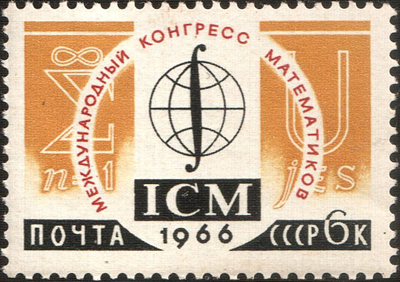
A stamp issued to celebrate the 1966 ICM in Moscow.
During the 1950s, however, we see a similar pattern to that of the 1920s: numbers of Soviet delegates at the ICMs gradually increased in the years following Stalin's death in 1953. The USSR's involvement in the international mathematical community expanded in 1957 when it joined the International Mathematical Union, which had been re-founded on less prejudiced principles in 1950. The signal that the USSR was again fully engaged in world mathematics came in 1966 when it hosted the ICM that year in Moscow. Nearly 3,000 of the congress' roughly 4,300 delegates came from outside the USSR, the Westerners amongst them seizing the opportunity to visit such a seemingly alien city.
In the decades that followed the Moscow congress, the organisation of the ICMs was certainly not free of difficulties arising from the cold war political climate, or from the policies of the Soviet government. For instance, the second winner of the Fields Medal in Nice in 1970, the Russian mathematician S. P. Novikov, was denied permission to travel to collect the award, owing to his having publicly criticised the Soviet regime. Moving beyond the USSR, the ICM that was planned for Warsaw in 1982 had to be postponed a year following the declaration of martial law in Poland in December 1981. And, yet again, several Soviet mathematicians were prevented from attending the 1986 congress in Berkeley, California.
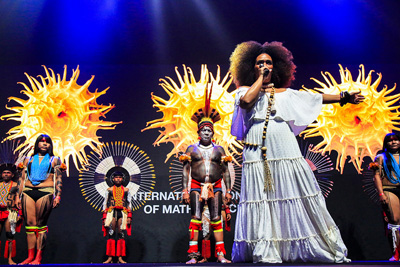
Modern ICMs attract thousands of delegates and are lavish affairs. This picture was taken at the opening ceremony at the 2018 ICM in Rio de Janeiro.
Overall, the International Congresses of Mathematicians provide an excellent means of studying the development of mathematics in the twentieth century: not only can we trace its technical developments and its trends by looking at the choices of plenary speakers, but we can also investigate the ways in which its conduct was affected by events in the wider world, and thereby see that mathematics is indeed a part of global culture.
Since the end of the cold war the ICMs have ventured outside of Europe and North America. A total of five have now taken place on non-European or North American soil: in Tokyo (1990), Beijing (2002), Hyderabad (2010), Seoul (2014), and Rio de Janeiro (2018). The Rio ICM, which took place in August this year, was also the first to be staged in the Southern hemisphere. In 2022 the ICM will return to the country whose mathematicians have perhaps suffered most from political tensions as far as their ability to travel is concerned: it will be hosted by Saint Petersburg, Russia.
About the author
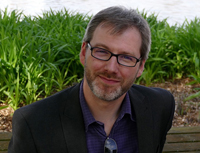
Christopher Hollings is a departmental lecturer in the Oxford Mathematical Institute, where he teaches the history of mathematics, and a Senior Research Fellow of The Queen's College, Oxford. He researches various topics from the history of nineteenth and twentieth century mathematics, including the impact of politics on mathematics, and the development of abstract algebra.